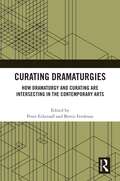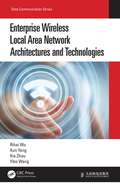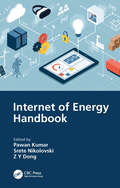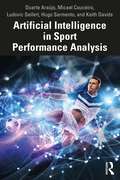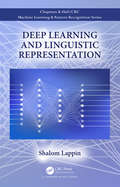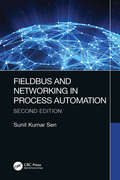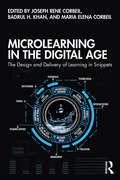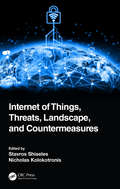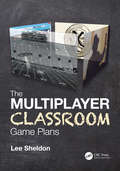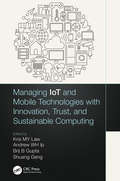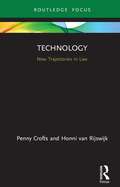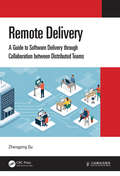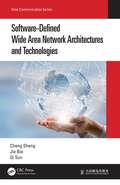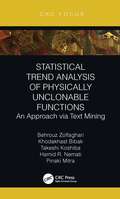- Table View
- List View
Curating Dramaturgies: How Dramaturgy and Curatorial Practices are Intersecting in the Contemporary Arts
by Peter Eckersall Bertie FerdmanCurating Dramaturgies investigates the transformation of art and performance and its impact on dramaturgy and curatorship. Addressing contexts and processes of the performing arts as interconnecting with visual arts, this book features interviews with leading curators, dramaturgs and programmers who are at the forefront of working in, with, and negotiating the daily practice of interdisciplinary live arts. The book offers a view of praxis that combines perspectives on theory and practice and looks at the way that various arts institutions, practitioners and cultural agents have been working to change the way that art and performance have developed and experienced by spectators in the last decade. Curating Dramaturgies argues that cultural producers and scholars are becoming more cognizant of this overlapping and transforming field. The introductory essay by the editors explores the rise of interdisciplinary live arts and its ramifications in cultural and political terms. This is further elaborated in the interviews with 15 diversely placed arts professionals who are at the forefront of rethinking and consolidatingthe ever-evolving field of the visual arts and performance.
Enterprise Wireless Local Area Network Architectures and Technologies (Data Communication Series)
by Rihai Wu Xun Yang Xia Zhou Yibo WangThis book has been written with the support of Huawei's large accumulation of technical knowledge and experience in the WLAN field, as well as its understanding of customer service requirements. First, the book covers service challenges facing enterprise wireless networks, along with detailing the latest evolution of Wi-Fi standards, air interface performance, and methods for improving user experience in enterprise scenarios. Furthermore, it illustrates typical networking, planning, and scenario-specific design for enterprise WLANs, and provides readers with a comprehensive understanding of enterprise WLAN planning, design, and technical implementation, as well as suggestions for deployment. This is a practical and easy-to-understand guide to WLAN design, and is written for WLAN technical support and planning engineers, network administrators, and enthusiasts of network technology. Authors Rihai Wu is Chief Architect of Huawei's campus network WLAN solution with 16 years of experience in wireless communications product design and a wealth of expertise in network design and product development. He previously served as a designer and developer of products for Wideband Code Division Multiple Access (WCDMA), LTE indoor small cells, and WLAN. Xun Yang is a WLAN standard expert from Huawei. He has nine years of experience in formulating WLAN standards, and previously served as 802.11ac Secretary, 802.11ah PHY Ad-hoc Co-chair, and 802.11ax MU Ad Hoc Sub Group Co-chair. Mr. Yang oversees technical research, the promotion of standards, and industrialization in the WLAN field, and has filed more than 100 patents. Xia Zhou is a documentation engineer of Huawei's campus network WLAN solution. She has 10 years of experience in creating documents for campus network products. Ms. Zhou was previously in charge of writing manuals for Huawei data center switches, WLAN products, and campus network solutions. She is also the author of Campus Network Solution Deployment Guide and was a co-sponsor of technical sessions such as WLAN from Basics to Proficiency. Yibo Wang is a documentation engineer of Huawei's campus network WLAN solution. He has nine years of experience in creating documents for campus network products. Mr. Wang was previously in charge of writing manuals for Huawei switches, WLAN products, and routers. He was also a co-sponsor of technical sessions such as WLAN from Basics to Proficiency and HCIA-WLAN certification training courses.
Enterprise Wireless Local Area Network Architectures and Technologies (Data Communication Series)
by Rihai Wu Xun Yang Xia Zhou Yibo WangThis book has been written with the support of Huawei's large accumulation of technical knowledge and experience in the WLAN field, as well as its understanding of customer service requirements. First, the book covers service challenges facing enterprise wireless networks, along with detailing the latest evolution of Wi-Fi standards, air interface performance, and methods for improving user experience in enterprise scenarios. Furthermore, it illustrates typical networking, planning, and scenario-specific design for enterprise WLANs, and provides readers with a comprehensive understanding of enterprise WLAN planning, design, and technical implementation, as well as suggestions for deployment. This is a practical and easy-to-understand guide to WLAN design, and is written for WLAN technical support and planning engineers, network administrators, and enthusiasts of network technology. Authors Rihai Wu is Chief Architect of Huawei's campus network WLAN solution with 16 years of experience in wireless communications product design and a wealth of expertise in network design and product development. He previously served as a designer and developer of products for Wideband Code Division Multiple Access (WCDMA), LTE indoor small cells, and WLAN. Xun Yang is a WLAN standard expert from Huawei. He has nine years of experience in formulating WLAN standards, and previously served as 802.11ac Secretary, 802.11ah PHY Ad-hoc Co-chair, and 802.11ax MU Ad Hoc Sub Group Co-chair. Mr. Yang oversees technical research, the promotion of standards, and industrialization in the WLAN field, and has filed more than 100 patents. Xia Zhou is a documentation engineer of Huawei's campus network WLAN solution. She has 10 years of experience in creating documents for campus network products. Ms. Zhou was previously in charge of writing manuals for Huawei data center switches, WLAN products, and campus network solutions. She is also the author of Campus Network Solution Deployment Guide and was a co-sponsor of technical sessions such as WLAN from Basics to Proficiency. Yibo Wang is a documentation engineer of Huawei's campus network WLAN solution. He has nine years of experience in creating documents for campus network products. Mr. Wang was previously in charge of writing manuals for Huawei switches, WLAN products, and routers. He was also a co-sponsor of technical sessions such as WLAN from Basics to Proficiency and HCIA-WLAN certification training courses.
Internet of Energy Handbook
by Pawan Kumar Srete Nikolovski Z. Y. DongThe Internet of Energy (IoE), with the integration of advanced information and communication technologies (ICT), has led to a transformation of traditional networks to smart systems. Internet of Energy Handbook provides updated knowledge in the field of energy management with an Internet of Things (IoT) perspective. Features Explains the technological developments for energy management leading to a reduction in energy consumption through topics like smart energy systems, smart sensors, communication, techniques, and utilization Includes dedicated sections covering varied aspects related to renewable sources of energy, power distribution, and generation Incorporates energy efficiency, optimization, and sensor technologies Covers multidisciplinary aspects in computational intelligence and IoT Discusses building energy management aspects including temperature, humidity, the number of persons involved, and light intensity This handbook is aimed at graduate students, researchers, and professionals interested in power systems, IoT, smart grids, electrical engineering, and transmission.
Internet of Energy Handbook
by Pawan Kumar Srete Nikolovski Z Y DongThe Internet of Energy (IoE), with the integration of advanced information and communication technologies (ICT), has led to a transformation of traditional networks to smart systems. Internet of Energy Handbook provides updated knowledge in the field of energy management with an Internet of Things (IoT) perspective. Features Explains the technological developments for energy management leading to a reduction in energy consumption through topics like smart energy systems, smart sensors, communication, techniques, and utilization Includes dedicated sections covering varied aspects related to renewable sources of energy, power distribution, and generation Incorporates energy efficiency, optimization, and sensor technologies Covers multidisciplinary aspects in computational intelligence and IoT Discusses building energy management aspects including temperature, humidity, the number of persons involved, and light intensity This handbook is aimed at graduate students, researchers, and professionals interested in power systems, IoT, smart grids, electrical engineering, and transmission.
Artificial Intelligence in Sport Performance Analysis
by Duarte Araújo Micael S Couceiro Ludovic Seifert Hugo Sarmento Keith DavidsTo understand the dynamic patterns of behaviours and interactions between athletes that characterize successful performance in different sports is an important challenge for all sport practitioners. This book guides the reader in understanding how an ecological dynamics framework for use of artificial intelligence (AI) can be implemented to interpret sport performance and the design of practice contexts. By examining how AI methodologies are utilized in team games, such as football, as well as in individual sports, such as golf and climbing, this book provides a better understanding of the kinematic and physiological indicators that might better capture athletic performance by looking at the current state-of-the-art AI approaches. Artificial Intelligence in Sport Performance Analysis provides an all-encompassing perspective in an innovative approach that signals practical applications for both academics and practitioners in the fields of coaching, sports analysis, and sport science, as well as related subjects such as engineering, computer and data science, and statistics.
Artificial Intelligence in Sport Performance Analysis
by Duarte Araújo Micael S Couceiro Ludovic Seifert Hugo Sarmento Keith DavidsTo understand the dynamic patterns of behaviours and interactions between athletes that characterize successful performance in different sports is an important challenge for all sport practitioners. This book guides the reader in understanding how an ecological dynamics framework for use of artificial intelligence (AI) can be implemented to interpret sport performance and the design of practice contexts. By examining how AI methodologies are utilized in team games, such as football, as well as in individual sports, such as golf and climbing, this book provides a better understanding of the kinematic and physiological indicators that might better capture athletic performance by looking at the current state-of-the-art AI approaches. Artificial Intelligence in Sport Performance Analysis provides an all-encompassing perspective in an innovative approach that signals practical applications for both academics and practitioners in the fields of coaching, sports analysis, and sport science, as well as related subjects such as engineering, computer and data science, and statistics.
Deep Learning and Linguistic Representation
by Shalom LappinThe application of deep learning methods to problems in natural language processing has generated significant progress across a wide range of natural language processing tasks. For some of these applications, deep learning models now approach or surpass human performance. While the success of this approach has transformed the engineering methods of machine learning in artificial intelligence, the significance of these achievements for the modelling of human learning and representation remains unclear. Deep Learning and Linguistic Representation looks at the application of a variety of deep learning systems to several cognitively interesting NLP tasks. It also considers the extent to which this work illuminates our understanding of the way in which humans acquire and represent linguistic knowledge. Key Features: combines an introduction to deep learning in AI and NLP with current research on Deep Neural Networks in computational linguistics. is self-contained and suitable for teaching in computer science, AI, and cognitive science courses; it does not assume extensive technical training in these areas. provides a compact guide to work on state of the art systems that are producing a revolution across a range of difficult natural language tasks.
Deep Learning and Linguistic Representation
by Shalom LappinThe application of deep learning methods to problems in natural language processing has generated significant progress across a wide range of natural language processing tasks. For some of these applications, deep learning models now approach or surpass human performance. While the success of this approach has transformed the engineering methods of machine learning in artificial intelligence, the significance of these achievements for the modelling of human learning and representation remains unclear. Deep Learning and Linguistic Representation looks at the application of a variety of deep learning systems to several cognitively interesting NLP tasks. It also considers the extent to which this work illuminates our understanding of the way in which humans acquire and represent linguistic knowledge. Key Features: combines an introduction to deep learning in AI and NLP with current research on Deep Neural Networks in computational linguistics. is self-contained and suitable for teaching in computer science, AI, and cognitive science courses; it does not assume extensive technical training in these areas. provides a compact guide to work on state of the art systems that are producing a revolution across a range of difficult natural language tasks.
Fieldbus and Networking in Process Automation
by Sunit Kumar SenOver the last two decades, fieldbus has totally revolutionized the way communication takes place in the fields of process control, automation, and manufacturing industries. Recent introduction of real-time fieldbuses has opened up its application in multi-axis motor control and other time-critical applications. Fieldbus is designed to ensure easy interoperability, smarter network designs, increased data availability, and lessened stress on the design aspects of safety protocols. This second edition of Fieldbus and Networking in Process Automation discusses the different facets of fieldbus technology including design, wiring, installation, and commissioning as well as safety aspects in hostile application areas. The book: • Explains basic communication principles and networking—a must for understanding fieldbuses • Considers the advantages and shortcomings of individual fieldbuses • Provides a broad spectrum of different fieldbuses used in both process control and manufacturing industries in a precise and to-the-point manner • Introduces Common Industrial Protocol (CIP), EtherNet/IP, EtherCAT, SERCOS III, Powerlink, and Profinet IRT, which are mostly sought after in control and automation fields • Discusses hard real-time communication in a succinct manner—so essential in today’s multi-axis motor control systems • Updates and streamlines the extra details from the original book to make it more concise and reader friendly Sunit Kumar Sen, a member of IET, holds advanced degrees from St Xavier’s College and University of Calcutta, both in Kolkata, India. He was an ex-professor in the Instrumentation Engineering section of the Department of Applied Physics, University of Calcutta, and taught courses in digital electronics, communication, industrial instrumentation, microprocessors, electrical networks, and fieldbuses. He was the head of the Department of Applied Physics and University Science Instrumentation Center from 2008-2010 at the University of Calcutta. Previously, he was assistant manager, instrumentation (oprn.) at the Bokaro Steel Plant, Jharkhand, India, under the Steel Authority of India (SAIL). He has already written four books in the areas of instrumentation, microprocessors, and industrial automation technologies. He has been published in approximately 70 national and international journals and conferences.
Fieldbus and Networking in Process Automation
by Sunit Kumar SenOver the last two decades, fieldbus has totally revolutionized the way communication takes place in the fields of process control, automation, and manufacturing industries. Recent introduction of real-time fieldbuses has opened up its application in multi-axis motor control and other time-critical applications. Fieldbus is designed to ensure easy interoperability, smarter network designs, increased data availability, and lessened stress on the design aspects of safety protocols. This second edition of Fieldbus and Networking in Process Automation discusses the different facets of fieldbus technology including design, wiring, installation, and commissioning as well as safety aspects in hostile application areas. The book: • Explains basic communication principles and networking—a must for understanding fieldbuses • Considers the advantages and shortcomings of individual fieldbuses • Provides a broad spectrum of different fieldbuses used in both process control and manufacturing industries in a precise and to-the-point manner • Introduces Common Industrial Protocol (CIP), EtherNet/IP, EtherCAT, SERCOS III, Powerlink, and Profinet IRT, which are mostly sought after in control and automation fields • Discusses hard real-time communication in a succinct manner—so essential in today’s multi-axis motor control systems • Updates and streamlines the extra details from the original book to make it more concise and reader friendly Sunit Kumar Sen, a member of IET, holds advanced degrees from St Xavier’s College and University of Calcutta, both in Kolkata, India. He was an ex-professor in the Instrumentation Engineering section of the Department of Applied Physics, University of Calcutta, and taught courses in digital electronics, communication, industrial instrumentation, microprocessors, electrical networks, and fieldbuses. He was the head of the Department of Applied Physics and University Science Instrumentation Center from 2008-2010 at the University of Calcutta. Previously, he was assistant manager, instrumentation (oprn.) at the Bokaro Steel Plant, Jharkhand, India, under the Steel Authority of India (SAIL). He has already written four books in the areas of instrumentation, microprocessors, and industrial automation technologies. He has been published in approximately 70 national and international journals and conferences.
Microlearning in the Digital Age: The Design and Delivery of Learning in Snippets
by Joseph-Rene Corbeil Badrul H. Khan Maria Elena CorbeilMicrolearning in the Digital Age explores the design and implementation of bite-sized learning and training in technology-enabled environments. Grounded in research-based best practices and a robust, eight-dimensional framework, this book applies the latest developments in mobile learning, social media, and instructional/multimedia design to one of today’s most innovative and accessible content delivery systems. Featuring experts from higher education, information technology, digital gaming, corporate, and other contexts, this comprehensive guide will prepare graduate students, researchers, and professionals of instructional design, e-learning, and distance education to develop engaging, cost-effective microlearning systems.
Microlearning in the Digital Age: The Design and Delivery of Learning in Snippets
by Joseph Rene CorbeilMicrolearning in the Digital Age explores the design and implementation of bite-sized learning and training in technology-enabled environments. Grounded in research-based best practices and a robust, eight-dimensional framework, this book applies the latest developments in mobile learning, social media, and instructional/multimedia design to one of today’s most innovative and accessible content delivery systems. Featuring experts from higher education, information technology, digital gaming, corporate, and other contexts, this comprehensive guide will prepare graduate students, researchers, and professionals of instructional design, e-learning, and distance education to develop engaging, cost-effective microlearning systems.
Internet of Things, Threats, Landscape, and Countermeasures
by Stavros Shiaeles Nicholas KolokotronisInternet of Things (IoT) is an ecosystem comprised of heterogeneous connected devices that communicate to deliver capabilities making our living, cities, transport, energy, and other areas more intelligent. This book delves into the different cyber-security domains and their challenges due to the massive amount and the heterogeneity of devices. This book introduces readers to the inherent concepts of IoT. It offers case studies showing how IoT counteracts the cyber-security concerns for domains. It provides suggestions on how to mitigate cyber threats by compiling a catalogue of threats that currently comprise the contemporary threat landscape. It then examines different security measures that can be applied to system installations or operational environment and discusses how these measures may alter the threat exploitability level and/or the level of the technical impact. Professionals, graduate students, researchers, academicians, and institutions that are interested in acquiring knowledge in the areas of IoT and cyber-security, will find this book of interest.
Internet of Things, Threats, Landscape, and Countermeasures
by Stavros Shiaeles Nicholas KolokotronisInternet of Things (IoT) is an ecosystem comprised of heterogeneous connected devices that communicate to deliver capabilities making our living, cities, transport, energy, and other areas more intelligent. This book delves into the different cyber-security domains and their challenges due to the massive amount and the heterogeneity of devices. This book introduces readers to the inherent concepts of IoT. It offers case studies showing how IoT counteracts the cyber-security concerns for domains. It provides suggestions on how to mitigate cyber threats by compiling a catalogue of threats that currently comprise the contemporary threat landscape. It then examines different security measures that can be applied to system installations or operational environment and discusses how these measures may alter the threat exploitability level and/or the level of the technical impact. Professionals, graduate students, researchers, academicians, and institutions that are interested in acquiring knowledge in the areas of IoT and cyber-security, will find this book of interest.
The Multiplayer Classroom: Game Plans
by Lee SheldonThe Multiplayer Classroom: Game Plans is a companion to The Multiplayer Classroom: Designing Coursework as a Game, now in its second edition from CRC Press. This book covers four multiplayer classroom projects played in the real world in real time to teach and entertain. They were funded by grants or institutions, collaborations between Lee Sheldon, as writer/designer, and subject matter experts in various fields. They are written to be accessible to anyone--designer, educator, or layperson--interested in game-based learning. The subjects are increasingly relevant in this day and age: physical fitness, Mandarin, cybersecurity, and especially an online class exploring culture and identity on the internet that is unlike any online class you have ever seen. Read the annotated, often-suspenseful stories of how each game, with its unique challenges, thrills, and spills, was built. Lee Sheldon began his writing career in television as a writer-producer, eventually writing more than 200 shows ranging from Charlie’s Angels (writer) to Edge of Night (head writer) to Star Trek: The Next Generation (writer-producer). Having written and designed more than forty commercial and applied video games, Lee spearheaded the first full writing for games concentration in North America at Rensselaer Polytechnic Institute and the second writing concentration at Worcester Polytechnic Institute. He is a regular lecturer and consultant on game design and writing in the United States and abroad. His most recent commercial game, the award-winning The Lion’s Song, is currently on Steam. For the past two years he consulted on an "escape room in a box," funded by NASA, that gives visitors to hundreds of science museums and planetariums the opportunity to play colonizers on the moon. He is currently writing his second mystery novel.
The Multiplayer Classroom: Game Plans
by Lee SheldonThe Multiplayer Classroom: Game Plans is a companion to The Multiplayer Classroom: Designing Coursework as a Game, now in its second edition from CRC Press. This book covers four multiplayer classroom projects played in the real world in real time to teach and entertain. They were funded by grants or institutions, collaborations between Lee Sheldon, as writer/designer, and subject matter experts in various fields. They are written to be accessible to anyone--designer, educator, or layperson--interested in game-based learning. The subjects are increasingly relevant in this day and age: physical fitness, Mandarin, cybersecurity, and especially an online class exploring culture and identity on the internet that is unlike any online class you have ever seen. Read the annotated, often-suspenseful stories of how each game, with its unique challenges, thrills, and spills, was built. Lee Sheldon began his writing career in television as a writer-producer, eventually writing more than 200 shows ranging from Charlie’s Angels (writer) to Edge of Night (head writer) to Star Trek: The Next Generation (writer-producer). Having written and designed more than forty commercial and applied video games, Lee spearheaded the first full writing for games concentration in North America at Rensselaer Polytechnic Institute and the second writing concentration at Worcester Polytechnic Institute. He is a regular lecturer and consultant on game design and writing in the United States and abroad. His most recent commercial game, the award-winning The Lion’s Song, is currently on Steam. For the past two years he consulted on an "escape room in a box," funded by NASA, that gives visitors to hundreds of science museums and planetariums the opportunity to play colonizers on the moon. He is currently writing his second mystery novel.
Managing IoT and Mobile Technologies with Innovation, Trust, and Sustainable Computing
by Kris M. Y. Law Andrew W. H. Ip Brij B. Gupta Shuang GengFocused on the latest mobile technologies, this book addresses specific features (such as IoT) and their adoptions that aim to enable excellence in business in Industry 4.0. Furthermore, this book explores how the adoption of these technologies is related to rising concerns about privacy and trusted communication issues that concern management and leaders of business organizations. Managing IoT and Mobile Technologies with Innovation, Trust, and Sustainable Computing not only targets IT experts and drills down on the technical issues but also provides readers from various groups with a well-linked concept about how the latest trends of mobile technologies are closely related to daily living and the workplace at managerial and even individual levels.
Managing IoT and Mobile Technologies with Innovation, Trust, and Sustainable Computing
by Edited by Kris MY Law, Andrew WH Ip, Brij B Gupta and Shuang GengFocused on the latest mobile technologies, this book addresses specific features (such as IoT) and their adoptions that aim to enable excellence in business in Industry 4.0. Furthermore, this book explores how the adoption of these technologies is related to rising concerns about privacy and trusted communication issues that concern management and leaders of business organizations. Managing IoT and Mobile Technologies with Innovation, Trust, and Sustainable Computing not only targets IT experts and drills down on the technical issues but also provides readers from various groups with a well-linked concept about how the latest trends of mobile technologies are closely related to daily living and the workplace at managerial and even individual levels.
Technology: New Trajectories in Law (New Trajectories in Law)
by Penny Crofts Honni van RijswijkPlacing contemporary technological developments in their historical context, this book argues for the importance of law in their regulation. Technological developments are focused upon overcoming physical and human constraints. There are no normative constraints inherent in the quest for ongoing and future technological development. In contrast, law proffers an essential normative constraint. Just because we can do something, does not mean that we should. Through the application of critical legal theory and jurisprudence to pro-actively engage with technology, this book demonstrates why legal thinking should be prioritised in emerging technological futures. This book articulates classic skills and values such as ethics and justice to ensure that future and ongoing legal engagements with socio-technological developments are tempered by legal normative constraints. Encouraging them to foreground questions of justice and critique when thinking about law and technology, the book addresses law students and teachers, lawyers and critical thinkers concerned with the proliferation of technology in our lives.
Remote Delivery: A Guide to Software Delivery through Collaboration between Distributed Teams
by Zhengping QuThis book records the author’s years of experience in the software industry. In his own practices, the author has found that the distributed work pattern has become increasingly popular in more and more work environments, either between vendors and customers or between different teams inside a company. This means that all practitioners in the software industry need to adapt to this new way of communication and collaboration and get skilled enough to meet the greater challenges in integrating the distributed work pattern with agile software delivery. By centering on the difficulties in communication and collaboration between distributed teams, this book digs into the reasons why so many remote delivery projects end up anticlimactic and provides solutions for readers’ reference. It also cites successful cases in promoting agile development in distributed teams, which has been a vexing problem for many software development companies. In addition, readers can find suggestions and measures for building self-managing teams in this book. Remote Delivery: A Guide to Software Delivery through Collaboration between Distributed Teams is a very practical guide for software delivery teams with their members distributed in different places and companies engaged in software customization. Developers, QAs, product managers, and project leaders can also be inspired by this book.
Remote Delivery: A Guide to Software Delivery through Collaboration between Distributed Teams
by Zhengping QuThis book records the author’s years of experience in the software industry. In his own practices, the author has found that the distributed work pattern has become increasingly popular in more and more work environments, either between vendors and customers or between different teams inside a company. This means that all practitioners in the software industry need to adapt to this new way of communication and collaboration and get skilled enough to meet the greater challenges in integrating the distributed work pattern with agile software delivery. By centering on the difficulties in communication and collaboration between distributed teams, this book digs into the reasons why so many remote delivery projects end up anticlimactic and provides solutions for readers’ reference. It also cites successful cases in promoting agile development in distributed teams, which has been a vexing problem for many software development companies. In addition, readers can find suggestions and measures for building self-managing teams in this book. Remote Delivery: A Guide to Software Delivery through Collaboration between Distributed Teams is a very practical guide for software delivery teams with their members distributed in different places and companies engaged in software customization. Developers, QAs, product managers, and project leaders can also be inspired by this book.
Software-Defined Wide Area Network Architectures and Technologies (Data Communication Series)
by Cheng Sheng Jie Bai Qi SunStarting with problems and challenges faced by enterprise WANs, Software-Defined Wide Area Network Architectures and Technologies provides a detailed description of SD-WAN’s background and basic features, as well as the system architecture, operating mechanism, and application scenarios of the SD-WAN solution based on the implementation of Huawei SD-WAN Solution. It also explains key SD-WAN technologies and analyzes real SD-WAN deployment cases, affording readers with design methods and deployment suggestions for the SD-WAN solution. The information presented in this book is easy to understand and very practical. It enables you to become adept in the SD-WAN solution’s implementation and design principles. The book is intended for ICT practitioners, such as network technical support engineers, network administrators, and network planning engineers, to use in studying theory. Furthermore, it serves as reference material for network technology enthusiasts. Authors Cheng Sheng is the Chief Architect of Huawei’s SD-WAN Solution. He has nearly 20 years of experience in network product and solution design, as well as extensive expertise in product design and development, network planning and design, and network engineering project implementation. Jie Bai is an Architect of Huawei’s SD-WAN Solution. He is well versed in Huawei security products and SD-WAN Solution and has written books such as Huawei Firewall Technology Talk as well as Huawei Anti-DDoS Technology Talk. Qi Sun is a Senior Information Architect of Huawei, and he is knowledgeable in Huawei SD-WAN Solution, CloudVPN Solution, and Cloud Management Solution. He also participated in the information architecture design and delivery of multiple solutions.
Software-Defined Wide Area Network Architectures and Technologies (Data Communication Series)
by Cheng Sheng Jie Bai Qi SunStarting with problems and challenges faced by enterprise WANs, Software-Defined Wide Area Network Architectures and Technologies provides a detailed description of SD-WAN’s background and basic features, as well as the system architecture, operating mechanism, and application scenarios of the SD-WAN solution based on the implementation of Huawei SD-WAN Solution. It also explains key SD-WAN technologies and analyzes real SD-WAN deployment cases, affording readers with design methods and deployment suggestions for the SD-WAN solution. The information presented in this book is easy to understand and very practical. It enables you to become adept in the SD-WAN solution’s implementation and design principles. The book is intended for ICT practitioners, such as network technical support engineers, network administrators, and network planning engineers, to use in studying theory. Furthermore, it serves as reference material for network technology enthusiasts. Authors Cheng Sheng is the Chief Architect of Huawei’s SD-WAN Solution. He has nearly 20 years of experience in network product and solution design, as well as extensive expertise in product design and development, network planning and design, and network engineering project implementation. Jie Bai is an Architect of Huawei’s SD-WAN Solution. He is well versed in Huawei security products and SD-WAN Solution and has written books such as Huawei Firewall Technology Talk as well as Huawei Anti-DDoS Technology Talk. Qi Sun is a Senior Information Architect of Huawei, and he is knowledgeable in Huawei SD-WAN Solution, CloudVPN Solution, and Cloud Management Solution. He also participated in the information architecture design and delivery of multiple solutions.
Statistical Trend Analysis of Physically Unclonable Functions: An Approach via Text Mining
by Behrouz Zolfaghari Khodakhast Bibak Takeshi Koshiba Hamid R. Nemati Pinaki MitraPhysically Unclonable Functions (PUFs) translate unavoidable variations in certain parameters of materials, waves, or devices into random and unique signals. They have found many applications in the Internet of Things (IoT), authentication systems, FPGA industry, several other areas in communications and related technologies, and many commercial products. Statistical Trend Analysis of Physically Unclonable Functions first presents a review on cryptographic hardware and hardware-assisted cryptography. The review highlights PUF as a mega trend in research on cryptographic hardware design. Afterwards, the authors present a combined survey and research work on PUFs using a systematic approach. As part of the survey aspect, a state-of-the-art analysis is presented as well as a taxonomy on PUFs, a life cycle, and an established ecosystem for the technology. In another part of the survey, the evolutionary history of PUFs is examined, and strategies for further research in this area are suggested. In the research side, this book presents a novel approach for trend analysis that can be applied to any technology or research area. In this method, a text mining tool is used which extracts 1020 keywords from the titles of the sample papers. Then, a classifying tool classifies the keywords into 295 meaningful research topics. The popularity of each topic is then numerically measured and analyzed over the course of time through a statistical analysis on the number of research papers related to the topic as well as the number of their citations. The authors identify the most popular topics in four different domains; over the history of PUFs, during the recent years, in top conferences, and in top journals. The results are used to present an evolution study as well as a trend analysis and develop a roadmap for future research in this area. This method gives an automatic popularity-based statistical trend analysis which eliminates the need for passing personal judgments about the direction of trends, and provides concrete evidence to the future direction of research on PUFs. Another advantage of this method is the possibility of studying a whole lot of existing research works (more than 700 in this book). This book will appeal to researchers in text mining, cryptography, hardware security, and IoT.
